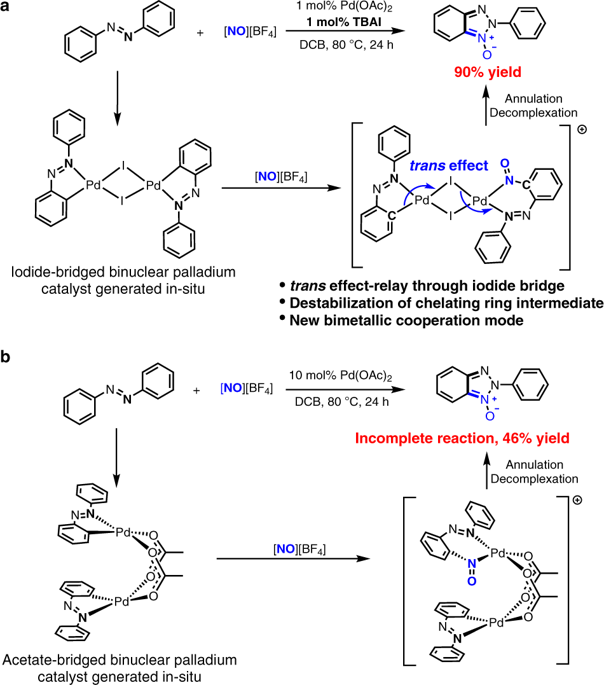Communications Chemistry ( IF 5.9 ) Pub Date : 2020-03-31 , DOI: 10.1038/s42004-020-0287-0 Yuanfei Zhang 1 , Zhe-Ning Chen 1 , Xiaofeng Zhang 1 , Xi Deng 1 , Wei Zhuang 1 , Weiping Su 1, 2

|
The prevalence of metalloenzymes with multinuclear metal complexes in their active sites inspires chemists’ interest in the development of multinuclear catalysts. Studies in this area commonly focus on binuclear catalysts containing either metal-metal bond or electronically discrete, conformationally advantageous metal centres connected by multidentate ligands, while in many multinuclear metalloenzymes the metal centres are bridged through μ2-ligands without a metal-metal bond. We report herein a μ2-iodide-bridged binuclear palladium catalyst which accelerates the C-H nitrosation/annulation reaction and significantly enhances its yield compared with palladium acetate catalyst. The superior activity of this binuclear palladium catalyst is attributed to the trans effect-relay through the iodide bridge from one palladium sphere to the other palladium sphere, which facilitates dissociation of the stable six-membered chelating ring in palladium intermediate and accelerates the catalytic cycle. Such a trans effect-relay represents a bimetallic cooperation mode and may open an avenue to design and develop multinuclear catalysts.
中文翻译:

碘化物增强的钯催化通过形成碘化物桥连双核钯络合物
在其活性位点具有多核金属络合物的金属酶的流行激发了化学家对多核催化剂开发的兴趣。该领域的研究通常集中在含有金属-金属键或电子离散、构象优势金属中心的双核催化剂上,这些金属中心由多齿配体连接,而在许多多核金属酶中,金属中心通过 μ2-配体桥接而没有金属-金属键。我们在此报道了一种 μ2-碘化物桥联双核钯催化剂,与醋酸钯催化剂相比,它可加速 CH 亚硝化/环化反应并显着提高其产率。这种双核钯催化剂的优异活性归因于反式通过碘化物桥从一个钯球传递到另一个钯球,促进钯中间体中稳定的六元螯合环的解离,加速催化循环。这种反式效应继电器代表了一种双金属合作模式,可能为设计和开发多核催化剂开辟一条道路。


























 京公网安备 11010802027423号
京公网安备 11010802027423号